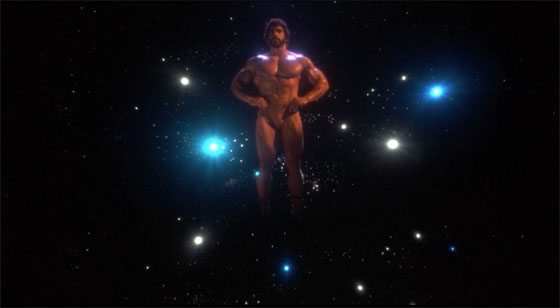
In the late 70’s and early 80’s, writer/director Luigi Cozzi was on his way to becoming the Italian Roger Corman. In fact, Corman had dubbed, edited, and distributed the American cut of Cozzi’s Star Wars rip-off Starcrash (1978). When Alien (1979) launched a trend of R-rated science fiction horror, Cozzi answered with Contamination (1980). Then Clash of the Titans (1981) hit the box office, and Cozzi watched the film, absorbed it, and eventually released a warped reflection with Hercules (1983), produced by Menahem Golan and Yoram Globus (the impresarios who brought us The Apple, among many other slices of 80’s cheese). Clash of the Titans wasn’t just the swan song of Ray Harryhausen; it was the last major film to lean heavily upon stop-motion special effects, which would only be used in limited, carefully-disguised fashion by filmmakers until CG could finally take its place. But Cozzi loved Harryhausen films, and had already paid homage with numerous stop-motion sequences in Starcrash, including a direct and incredibly awkward recreation of the famous Talos sequence in Jason and the Argonauts (1963); his ode to Clash of the Titans wasn’t going to hold back, regardless of modern FX trends. Neither was he going to worry overmuch that the stop-motion effects at his disposal looked just as clumsy and cheap as they did on the hastily-made Starcrash (much of the same FX team was brought back, supervised by Armando Valcauda). He had a vision. His Hercules would have little to do with the sword-and-sandal films that Italy mass-produced in the 60’s. His would be a visual continuation of the world of Starcrash, a science fiction interpretation of Greek mythology.
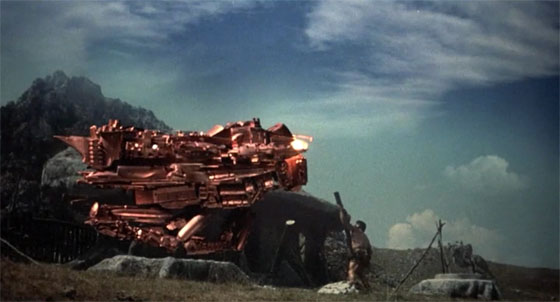
Hercules (Lou Ferrigno) battles a stop-motion-animated mechanical insect.
Actually, what he produced was a film with the look of an 80’s Saturday morning cartoon, toy commercials and all.* Lou Ferrigno, fresh off The Incredible Hulk TV series and looking to launch a movie career, sprouts a neatly-trimmed beard, oils up, and leads the cast as our hero Herc, flexing his muscles, swinging his sword, and looking increasingly bemused as his meandering journey takes him from one psychedelic setpiece to the next. At one point, the sorceress Circe (Mirella D’Angelo, looking like a “Babooshka”-era Kate Bush), who has been leading Hercules from one task to another for about thirty minutes, abruptly dies; Hercules just stands there for a moment, staring at her, and then looks around, looking like a lost puppy. I couldn’t help him; I couldn’t remember what his quest was, either. Let’s see…oh, yes: Sybil Danning, staple of 80’s cheesecake (Battle Beyond the Stars, Chained Heat), plays the villainess, Princess Ariadna, who conspires to make Augeias (Brad Harris) ruler of Thebes by hiring assassins to kill the king and queen. But the royal offspring, the infant prince, Hercules, is secreted out of the palace and set adrift down a river in a boat. Now, Hercules has already been chosen by Zeus (Claudio Cassinelli) to be endowed with super-strength, so that he can fight Evil, which has been unleashed upon the world by the breaking of Pandora’s Jar. So when Hera (Rossana Podestà), resentful of her husband’s illegitimate child, sets two serpents/puppets to kill Hercules, the gurgling little kid finds the inner resources to destroy them. It’s pretty cute:
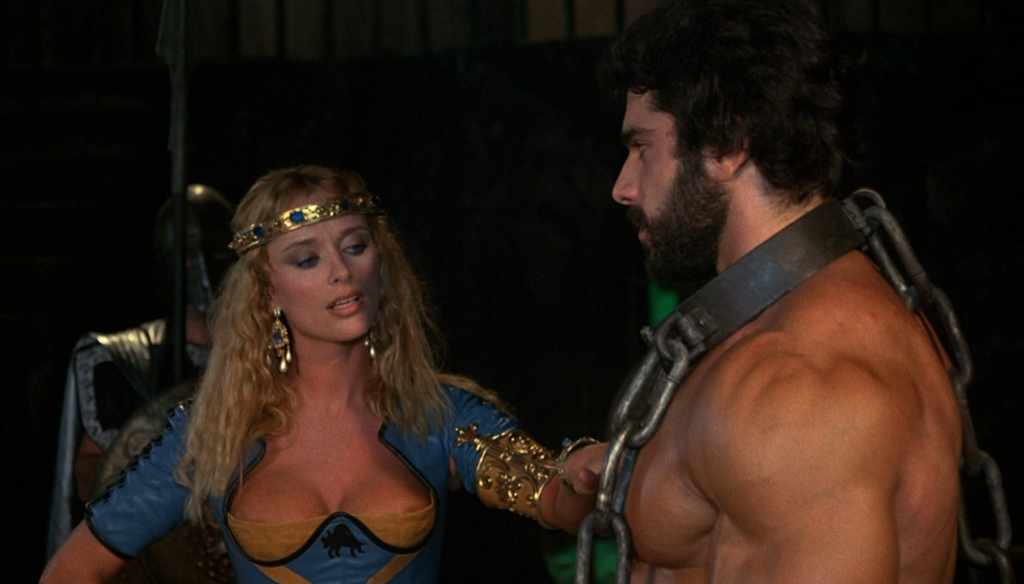
Adriana (Sybil Danning) tempts Hercules.
Raised by a husband and wife who find the super-strong orphan (Superman), Hercules grows his muscles to bodybuilder levels by turning a massive wheel (Conan the Barbarian). But Hera, not one to give up easily, soon sets a grizzly bear against Herc’s father, killing him; Herc attacks the stock footage and wrestles with a man in a bear costume. Then Hera enlists King Minos (William Berger) to slay Hercules. Minos agrees, though he’s also a big advocate of science over religion, which he likes to point out endlessly. He enlists his inventor, Daedalus, who in this telling is a scantily-clad woman (Eva Robbins). Daedalus builds a giant mechanical flying insect that kills Herc’s mother, and is defeated when our hero short-circuits it with a spear to its AA battery pack. After building a funeral pyre and solemnly lighting it (again, Conan the Barbarian), Hercules sets about on his restless journeys, first to Tyre, where he meets the evil Augeias and becomes champion in a fighting tournament (which ends with him hurling a giant log into outer space). He falls in love with Princess Cassiopeia (Ingrid Anderson), but when she’s captured by Augeias and Ariadna, he’s set on a long quest to end their tyranny and rescue the princess, with Hera placing various obstacles – most of them poorly-staged special effects – in his path.
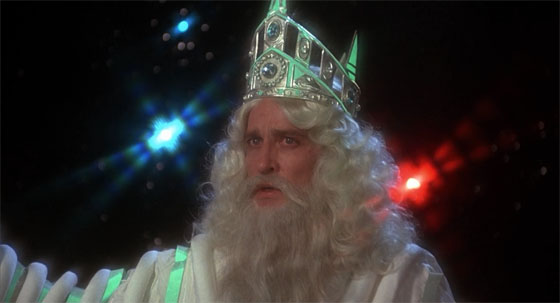
Zeus (Claudio Cassinelli) exerts his will from a cosmic plane.
Rather than having his gods sitting atop a misty Mount Olympus, Cozzi places them on another planet, in front of a multi-colored starfield and amidst strange rock formations. Zeus wears an obviously phony white beard that doesn’t quite fit his narrow, youthful face; his crown looks like it was bought at a discount bin at Toys ‘R’ Us. The costumes worn by Hera and Athena (Delia Boccardo) are more 80’s New Wave, but just as awkward-fitting. Apparently under the impression that any kind of special effect will heighten the sense of movie magic, Cozzi ensures that not a scene goes by without some kind of distracting optical effect, whether it’s a poorly-matted background that doesn’t match against the foreground, or just random pulses of colored light, always accompanied by electronic hums and zaps. Therefore, the effects may be cheap, but there sure are a lot of them. Eschewing “realistic” monsters of Greek mythology, Cozzi once again uses mechanical creations which look like Transformer Dinobots. In a typical sequence, the monster hovers near Ferrigno, he pokes at it with a log or spear, and eventually it disappears in a ball of light. (This even happens when one creature falls into the sea. A splash of water arrives seconds too late and in the wrong place.) When Hercules travels to the Underworld, he battles a Cerberus, which summons some 80’s toy-store nostalgia:
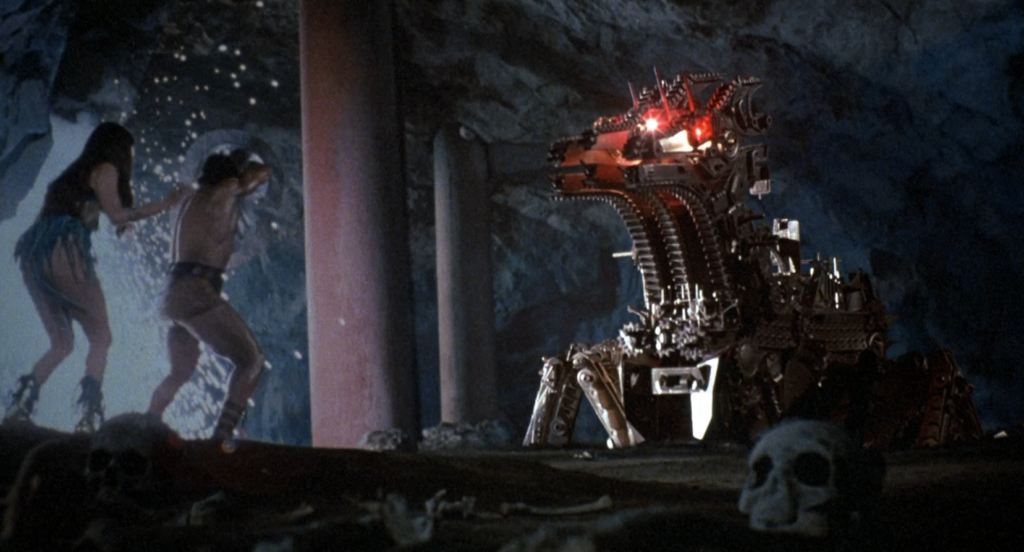
After even copying the ritual bathing/bare-bum scene from Clash of the Titans, Cozzi puts together a climax in which Augeias gets to wield a flaming sword – with horizontal bands of different colors, so it looks like a rocket popsicle. Princess Cassiopeia, wearing pasties on her bare breasts, is lowered slowly toward a flaming lava pit (for once, foreshadowing a movie, in this case Indiana Jones and the Temple of Doom). Hercules is rewarded not just by gaining the princess, whom he hardly knows, but having her body inhabited by the spirit of his dead love Circe…or something. Then they become constellations, the fate of all Greek demigods, and because that also happened in Clash of the Titans. As I mentioned in my Starcrash review, I saw this film at the drive-in when it was released; it was an incoherent jumble then, and it’s an incoherent jumble now. But the off-kilter charm remains – not a scene passes which isn’t handled with a goofy incompetence. Nonetheless, there was a sequel, The Adventures of Hercules (1985), and, because the universe was not yet satisfied, Cozzi was reunited with Ferrigno again for Sinbad of the Seven Seas (1989), a troubled production which Cozzi was fired from, and then re-hired to fix the work of his replacement, Enzo Castellari. Cozzi, who directed the Ferrigno films under the pseudonym Lewis Coates, now co-owns the legendary Profondo Rosso shop in Italy with fellow filmmaker Dario Argento.
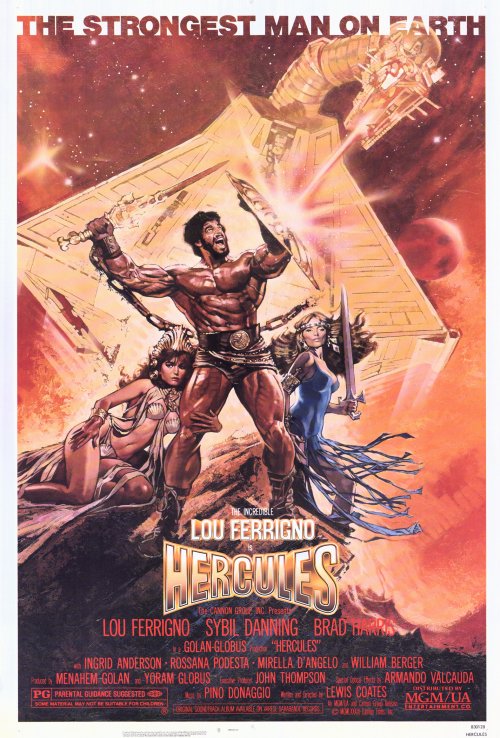
* In the early 80’s, particularly in Saturday Morning cartoons, it seemed like every concept had to have a Star Wars-inspired, science fiction angle. The pop cultural impact of George Lucas was inescapable, like a black hole drawing in all other artifacts of the era. Actually, the one cartoon Hercules resembles the most is the anime Ulysses 31, a well-animated science fiction update of The Odyssey which ran from 1981-82.









